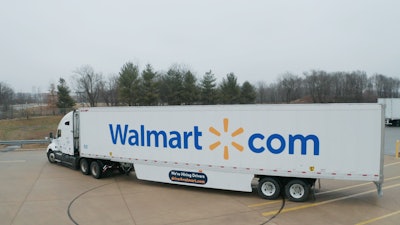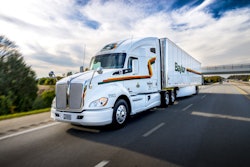 Walmart intends to hire an additional 500 drivers by the end of July, hoping to expand its fleet to nearly 9,600 drivers.
Walmart intends to hire an additional 500 drivers by the end of July, hoping to expand its fleet to nearly 9,600 drivers.Walmart Transportation, which last year aggressively grew its private fleet by 900 drivers, hopes to continue that growth this year by adding another 500 drivers in the coming months. The fleet’s expansion is meant to serve a two-fold purpose: To keep up with demand from the retail giant’s sales growth both in stores and online and to bring more of its transportation needs in house — and away from the for-hire market.
“We see it as a competitive advantage,” said Joe Metzger, senior vice president of transportation of Walmart Transportation, of moving more of its transportation in house. “Our private fleet continues to do very well on safety, service and costs,” compared to outsourcing its transportation needs to other fleets.
Walmart’s fleet currently employs around 9,080 drivers, and Metzger said the company hopes to push that number to around 9,600 by the end of July.
More than continuing to move its trucking business in house and away from for-hire fleets, Walmart also is a daunting competitor in the driver recruiting space. And it’s likely many of the 500 drivers it plans to hire will be plucked from the for-hire ranks.
For instance, Walmart drivers average $87,500 annually in pay, and drivers that stay with the fleet can earn upwards of $100,000. That’s well above the annual averages of drivers who work in the for-hire segment. They also start receiving benefits, like retirement and health insurance, on the first day on the job, along with 21 paid days off their first year at the company.
However, the fleet isn’t relying solely on throwing money and benefits around in its driver recruiting efforts.
“It takes more than that type of compensation to get the quality drivers we’re looking for,” Metzger said. The fleet offers predictable home time and work schedules, and they don’t have to load or unload freight. “That’s a critical piece,” he says.
Walmart drivers don’t struggle with the same parking issues that most other fleets and drivers do. Walmart drivers can park at any Walmart or Sam’s Club locations – or any of the company’s distribution centers – for their 10-hour break.
Likewise, the company refreshes its fleet equipment regularly to provide “top tier equipment in the industry,” said Metzger.
Walmart holds regular week-long onboarding events to train new drivers and to “make sure they’re a good fit for our organization,” Metzger said. With its new round of hiring, the fleet also hopes to put an emphasis on expanding the number of women in its driver ranks. “We think that’s an important element of our growth,” he said.
Though Walmart doesn’t really have to compete with other trucking companies in the marketplace (with per-mile rates, profitability, etc.), the fleet is a case study in best practices in driver recruiting and retention. Last year, a Walmart spokesperson said its turnover rate was just 7% – compared to the for-hire industry average of more than 90% annually.
“Our No. 1 reason for turnover is retirement,” said Metzger. “We say we want this to be the last place” a driver works, he said, “and that is generally the case.”











